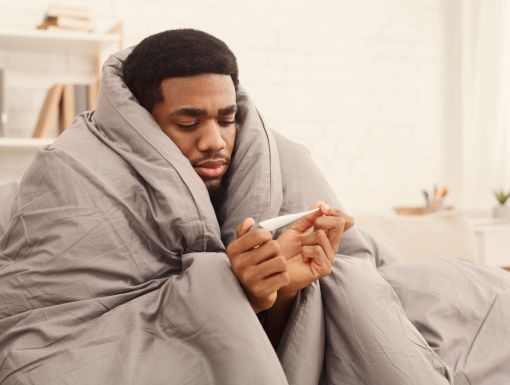
Body Aches and Chills
If you are experiencing chills along with body aches, there could be several reasons why. In most cases, there isn’t cause for alarm.
Chills are your body’s way of raising its core temperature. They’re often a sign that your body feels too cold or is fighting off an illness. Cold temperatures, viruses, infections and other illnesses can bring on chills.
When you shiver, your muscles relax and contract. This involuntary movement warms your body. Chills and fever often go together. But not everyone with a fever gets chills, and you can get chills with no fever.
When you have chills, you may shiver or tremble, have chattering teeth (your jaw feels like it’s rattling, sometimes with your teeth bumping together) or have goosebumps (small rash-like bumps on the skin).
For most people, the average body temperature is around 98.6 degrees Fahrenheit. A “normal” temperature can vary between 97- and 99-degrees Fahrenheit. Your body’s temperature naturally varies, but very low temperatures are dangerous.
These health conditions can cause chills:
- Bacterial infections like listeria, pneumonia and urinary tract infections (UTIs)
- Cancers, such as leukemia
- Drug withdrawal (substance abuse)
- Hangover
- Low blood sugar (hypoglycemia) in people with diabetes
- Menopausal night sweats or hot flashes
- Panic attacks
- Sepsis
- Viruses, including those that cause the flu
When should I contact my doctor?
You should contact your healthcare provider if you experience:
- Temperature above 104 degrees Fahrenheit or below 95 degrees Fahrenheit in an adult or a child older than three.
- Temperature above 102.2 degrees Fahrenheit in a child three months to three years.
- Chest pain or unexplained pain
- Extreme fatigue
- Severe abdominal pain
Body aches can often accompany chills. Body aches happen when your muscles, tendons and joints hurt.
The pain can be acute, meaning it is sudden and severe. Or the pain can be chronic (long-lasting). You may have localized pain (in one area of your body), or it may affect your entire body.
The most common types of body aches include:
- Joint pain: Stiffness and inflammation often accompany joint pain. For many people, joint pain gets better with rest and worsens with activity.
- Muscle pain: Muscle spasms, cramps and injuries can all cause muscle pain. Some infections may also lead to muscle pain.
- Tendon and ligament pain: Ligaments and tendons are strong bands of tissue that connect your joints and bones. Sprains, strains and overuse injuries can lead to tendon or ligament pain.
There are several ways to manage and treat body aches. Some solutions are as simple as over-the-counter pain relievers, while other treatments may require you to see a doctor. Treatments may include:
- Acupuncture
- Chiropractic adjustment
- Occupational therapy
- Pain relievers
- Physical therapy
- Steroid injections
- Therapeutic massage
- Hot and cold therapy
- Over-the-counter pain relievers
- Stretching exercises
- Stress reduction techniques
Usually, body aches improve with proper treatment. If pain interferes with your daily activities or how well you can function, it’s important that you speak with your doctor. Seek immediate medical help if you have severe pain from a sudden injury.


